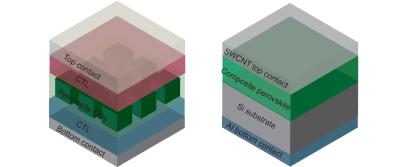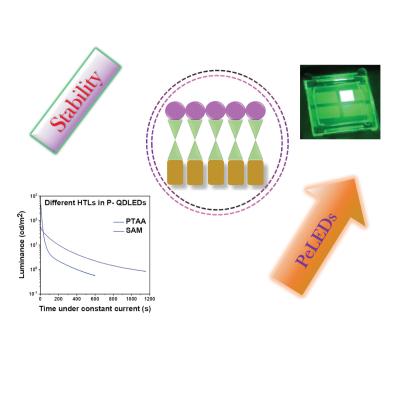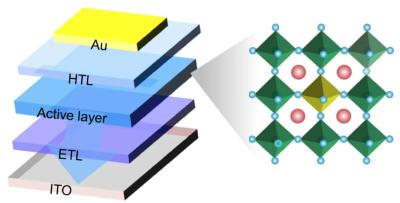What are perovskites?
Perovskite is a calcium titanium oxide mineral, with the chemical formula CaTiO3, discovered in the Ural Mountains of Russia by Gustav Rose in 1839 and named after Russian mineralogist Lev Perovski (1792–1856).
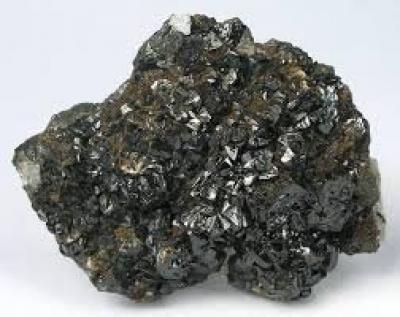
Perovskites are a class of materials with a similar structure that are easily synthesized and relatively low-cost. Perovskites are considered the future of solar cells and are also predicted to play a significant role in next-gen electric vehicle batteries, displays, sensors, lasers and much more.
Perovskites can have an impressive collection of interesting properties including “colossal magnetoresistance” - their electrical resistance changes when they are put in a magnetic field (which can be useful for microelectronics). Some Perovskites are superconductors, which means they can conduct electricity with no resistance at all. Perovskite materials exhibit many other interesting and intriguing properties. Ferroelectricity, charge ordering, spin dependent transport, high thermopower and the interplay of structural, magnetic and transport properties are commonly observed features in this family. Perovskites therefore hold exciting opportunities for physicists, chemists and material scientists.
What are LEDs?
A light-emitting diode (LED) is an electronic component that is essentially a two-lead semiconductor light source. It is a p–n junction diode that emits light upon activation by a voltage applied to the leads, which makes electrons recombine with electron holes within the device, releasing energy in the form of photons. This effect is called electroluminescence, and the color of the light is determined by the energy band gap of the chosen semiconductor.
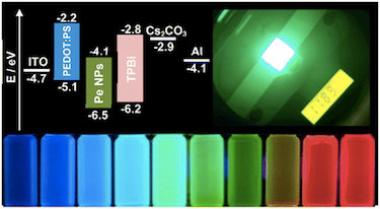
LEDs’ advantages over incandescent light sources include lower energy consumption, longer lifetime, improved physical robustness, smaller size, and faster switching. Light-emitting diodes have become ubiquitous and are found in diverse applications in the aerospace and automotive industries, as well as in advertising, traffic signals, camera flashes and much more.
LEDs meant for general room lighting currently remain more expensive than fluorescent or incandescent sources of similar output, but are significantly more energy efficient.
What can perovskites do for LEDs?
Current high-quality LEDs are based on direct bandgap semiconductors, but making these devices is no easy task because they need to be processed at high temperatures and in vacuum, which makes them rather expensive to produce in large quantities. Perovskites that are direct-bandgap semiconductors could be real alternatives to other types of direct-bandgap materials for applications like color displays, since they are cheap and easy to make and can be easily tuned to emit light of a variety of colors.
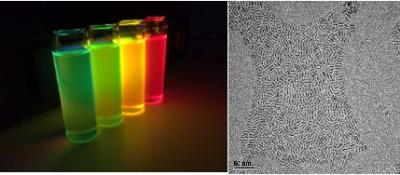
Researchers have found that organometal halide-based perovskites (a combination of lead, organics and halogens that arrange into perovskite crystal structure in the solid state) could be very suitable for making optoelectronics devices, since they can be processed in solution and do not need to be heated to high temperatures. This means that large-area films of these materials can be deposited onto a wide range of flexible or rigid substrates. The perovskites also have an optical bandgap that can be tuned in the visible to infrared regions, which makes them very promising for a range of optoelectronics applications. These materials also emit light very strongly, which makes them very suitable for making LEDs. The light emitted by the perovskites can be easily tuned, which could make them ideal for color displays and lighting, and in optical communication applications.
However, a major obstacle that perovskites will have to overcome in order to be used in LED-type devices is that electrons and holes only weakly bind in perovskite thin films. This means that excitons (electron-hole pairs) spontaneously dissociate into free carriers in the bulk recombination layer, leading to low photoluminescence quantum efficiency (PLQE), high leakage current and low luminous efficiency. This obviously impairs perovskites’ ability to create high-performance LEDs, and for perovskite materials to make a comparable impact in light emission, it is necessary to overcome their slow radiative recombination kinetics. Simply put, researchers will have to find ways of effectively confining electrons and holes in the perovskite so that they can “recombine” to emit light. Major progress is already being made in this field, and it seems that perovskites will indeed open the door to a low-cost, color-tunable approach to LED development.
Recent work in the field of perovskite-based LEDs
In July 2016, researchers at Nanyang Technological University in Singapore have fabricated high-performance green light-emitting diodes based on colloidal organometal perovskite nanoparticles. The devices have a maximum luminous efficiency of 11.49 cd/A, a power efficiency of 7.84 lm/W and an external quantum efficiency of 3.8%. This value is said to be about 3.5 times higher than that of the best colloidal perovskite quantum-dot-based LEDs previously made.
In March 2016, researchers at the University of Toronto in Canada and ShangaiTech University in China have succeeded in using colloidal quantum dots in a high-mobility perovskite matrix to make a near-infrared (NIR) light-emitting diode (LED) with a record electroluminescence power conversion efficiency of nearly 5% for this type of device. The NIR LED could find use in applications such as night vision devices, biomedical imaging, optical communications and computing.
In February 2016, researchers from the Universitat Jaume I and the Universitat de València have studied the interaction of two materials, halide perovskite and quantum dots, revealing significant potential for the development of advanced LEDs and more efficient solar cells. The researchers quantified the "exciplex state" resulting from the coupling of halide perovskites and colloidal quantum dots, both known separately for their optoelectronic properties, but when combined, these materials yield longer wavelengths than can be achieved by either material alone, plus easy tuning properties that together have the potential to introduce important changes in LED and solar technologies.
In December 2015, researchers at Pohang University in Korea are reportedly the first to develop a perovskite light emitting diode (PeLED) that could replace organic LED (OLED) and quantum dot LED (QDLED).
Organic/inorganic hybrid perovskite have much higher color-purity at a lower cost compared to organic emitters and inorganic QD emitters. However, LEDs based on perovskite had previously shown a limited luminous efficiency, mainly due to significant exciton (a complex of an electron and hole that can allow light emission when it is radiatively recombined) dissociation in perovskite layers. The research team overcame the efficiency limitations of PeLED and boosted its efficiency to a level similar to that of phosphorescent OLEDs. This increase was attributed to fine stoichiometric tuning that prevents exciton dissociation, and to nanograin engineering that reduces perovskite grain size, and concomitantly decreases exciton diffusion length. PeLED might be a game changer in the display and solid-state lighting industries, with significantly improved efficiency as well as advantages like excellent color gamut and low material cost.
In November 2015, Florida State researchers have developed a cheaper, more efficient LED, or light-emitting diode, using perovskites. The researchers spent months using synthetic chemistry to fine-tune the materials in the lab, creating a perovskite material capable of emitting a staggering 10,000 candelas per square meter when powered by 12 volts. The scientists say that such exceptional brightness owes, to a large extent, to the inherent high luminescent efficiency of this surface-treated, highly crystalline nanomaterial.
The latest perovskite LED news:
Researchers develop perovskite LEDs with an external quantum efficiency exceeding 30%
Researchers from Xiamen University and China Jiliang University have reported ultrahigh-efficiency green PeLEDs with quantum efficiencies surpassing a milestone of 30% by regulating the charge carrier transport and near-field light distribution to reduce electron leakage and achieve a high light outcoupling efficiency of 41.82%.
The scientists applies Ni0.9Mg0.1Ox films with a high refractive index and increased hole carrier mobility as the hole injection layer to balance the charge carrier injection and insert the polyethylene glycol layer between the hole transport layer and the perovskite emissive layer to block the electron leakage and reduce the photon loss.
Stanford team shows how water additives improve the efficiency of violet perovskite light-emitting diodes
Researchers from Stanford University have reported a novel way to improve the performance of perovskite light-emitting diodes (PeLEDs) in the violet region. The new method could represent a promising step toward cost-effective and efficient ultraviolet PeLEDs.
By engineering the crystallization process of spin-coated 2D perovskites with water, the resulting PeLEDs exhibit bright violet emission at 408 nm with an external quantum efficiency of 0.41%, a 5-fold increase over control devices.
Researchers design ITO-free silicon-integrated perovskite electrochemical cell for light-emission and light-detection
Researchers from Russia's Alferov University, ITMO University, Far Eastern Branch of Russian Academy of Sciences, Peter the Great St. Petersburg Polytechnic University, Skolkovo Institute of Science and Technology and China's Qingdao Innovation and Development Center have developed a novel design for a perovskite electrochemical cell for light-emission and light-detection, where the active layer consists of a composite material made of halide perovskite microcrystals, polymer support matrix, and added mobile ions.
Schematic diagrams of (a) the typical PeLED device structure, where CTL - charge transfer layer, QD - quantum dots and (b) the team's PeLEC device structure, where SWCNT - single-walled carbon nanotubes. Image from Opto-Electronic Advances.
The team explained that while halide perovskite light-emitting devices exhibit exceptional properties such as high efficiency, high color purity, and broad color gamut, their industrial integration generally suffers from the technological complexity of devices' multilayer structure alongside in-operation induced heating poor stability. Halide perovskite light-emitting electrochemical cells are a novel type of perovskite optoelectronic device that differs from the perovskite light-emitting diodes by a simple monolayered architecture.
Perovskite-Info launches a new edition of its Perovskite for Displays Market Report
Perovskite-Info is proud to announce an update to our Perovskite for the Display Industry Market Report. This market report, brought to you by the world's leading perovskite and OLED industry experts, is a comprehensive guide to next-generation perovskite-based solutions for the display industry that enable efficient, low cost and high-quality display devices. The report is now updated to May 2023, with all the latest commercial and research activity.
Reading this report, you'll learn all about:
- Perovskite materials and their properties
- Perovskite applications in the display industry
- Perovskite QDs for color conversion
- Prominent perovskite display related research activities
The report also provides a list of perovskite display companies, datasheets and brochures of pQD film solutions, an introduction to perovskite materials and processes, an introduction to emerging display technologies and more.
Researchers fabricate full-color flexible microLEDs using perovskite QDs
Researchers from Korea's KIMM institute have fabricated full-color flexible microLED devices, using blue LEDs and perovskite quantum dot color conversion layers. The demonstrated device featured 1 mm pixel pitch LEDs (25.4 PPI) and could be bent with a radius of 5 mm without being damaged.
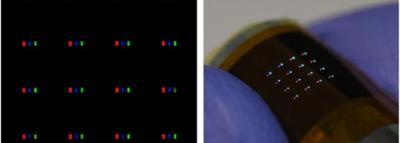
The researchers used a perovskite-QD and siloxane composite using ligand exchanged PQD with silane composite followed by surface activation by an addition of halide-anion containing salt. Due to this surface activation, the researchers say that it was possible to construct the PQD surface with a silane ligand using a non-polar organic solvent that does not damage the PQD. As a result, the ligand-exchanged PQD with a silane compound exhibited high dispersibility in the siloxane matrix and excellent atmospheric stability.
Researchers report molecular engineering strategy for efficient and stable deep-red perovskite LEDs
Researchers from Purdue University, Florida State University, University of Kentucky, Lawrence Berkeley National Laboratory, University of Houston, Rice University, China's Qilu University of Technology (Shandong Academy of Sciences) and Taiwan's National Cheng Kung University have found that LEDs based on halide perovskites can produce more vivid, colorful and brighter images. The recent research presents extremely efficient perovskite LED devices in the red color region.
Perovskite materials often tend to be less stable and can degrade quickly. Further, device efficiency has not been fully optimized to compete with conventional LEDs. “Our work aims to resolve these critical issues,” said Purdue's Letian Dou, who conceived the idea, supervised the project and provided funding support.
Researchers improve perovskite-based LEDs using self-assembled molecules
Researchers from the Institute of Chemical Research of Catalonia-The Barcelona Institute of Science and Technology (ICIQ-BIST), Centre Tecnològic de Catalunya EURECAT, Istituto Italiano di Tecnologia (IIT), ICREA and Universitat Rovira i Virgili have reported the application of two carbazole-based self-assembled molecules (SAMs) as hole injecting materials in perovskite-based LEDs.
Their structures differ in one phenyl ring in the bridge; however, the extra ring provides more stability to the devices, even surpassing the one obtained with the widely used polymer PTAA. In addition, due to the structural and electronic characteristics of the SAMs, the efficiency of the devices is also increased.
Researchers report on novel approach for high performance and spectrally stable deep-blue perovskite LEDs
Researchers from Yonsei University, Sungkyunkwan University and Institute for Basic Science (IBS) have proposed a rapid crystallization method based on hot-antisolvent bathing for realization of deep-blue perovskite light-emitting diodes (PeLEDs). The rapid crystallization method manipulates 2D perovskite phase evolution by controlling the crystallization kinetics for the fabrication of phase-pure 2D Ruddlesden‒Popper perovskites (2D-RPPs), enabling deep-blue-emissive perovskite LEDs.
PeLEDs are considered as promising candidates for next-generation solution-processed full-color displays. However, the external quantum efficiencies (EQEs) and operational stabilities of deep-blue (<460 nm) PeLEDs still lag far behind their red and green counterparts. 2D-RPPs have excellent optoelectronic properties—ideal for LEDs. Although 2D-RPP-based LEDs have rapidly progressed in terms of performance, it is still challenging to demonstrate blue-emissive and color-pure LEDs. The deep blue of current LED displays is usually produced by indium gallium nitride (InGaN), a costly substance. In the field of LEDs, researchers are seeking alternatives and one of them could be found in 2D-RPPs.
Researchers achieve single component white LEDs based on lanthanide ions doped lead halide perovskite
Researchers from China's Jilin University have developed a promising method to fabricate white perovskite LEDs using lanthanides (Ln3+) ions doped CsPbCl3 perovskite nanocrystals (PeNCs).
Lead halide perovskite nanocrystals (PeNCs) have attracted extensive attention due to their high photoluminescence quantum yield (PLQY), adjustable bandgap, low cost, and excellent photoelectric properties. In recent years, perovskite based light emitting diodes (LEDs) have developed rapidly and become candidates for low-cost, solution-processing based solid-state lighting. White light perovskite LEDs are possible to be obtained by stacking different NCs with complementary emissions together in one film. However, the halide ion segregation and exchange lead to severe color instability and complex structure in mixed halide perovskite LED devices. Therefore, new technologies are required for the development of white light devices.
The MicroLED Industry Association to host a Perovskite microLED technology webinar
On March 27 the MicroLED Industry Association will host a private webinar on perovskite materials for the microLED industry. Perovskite materials hold great promise for the solar industry and in recent years we are seeing promising signs for the adoption of perovskites the display industry.
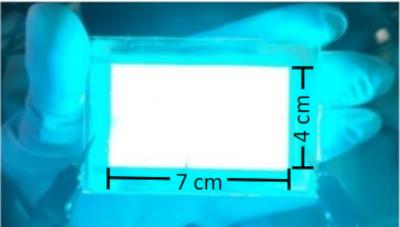
The upcoming Seminar will feature four world-leading speakers, and will also be open to a Q&A session. We will learn more about the state-of-the-art perovskite research and development, with a focus of course on applications in the microLED industry - for both perovskite QDs and PeLEDs.
Pagination
- Previous page
- Page 3
- Next page
